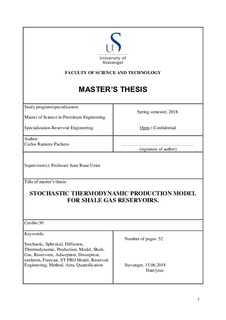| dc.contributor.advisor | Ursin, Jann Rune | |
| dc.contributor.author | Ramirez Pacheo, Carlos | |
| dc.date.accessioned | 2018-10-24T11:45:44Z | |
| dc.date.available | 2018-10-24T11:45:44Z | |
| dc.date.issued | 2018-06-15 | |
| dc.identifier.uri | http://hdl.handle.net/11250/2569330 | |
| dc.description | Master's thesis in Petroleum engineering | nb_NO |
| dc.description.abstract | Most operating companies use Decline Curve Analysis (DCA) for their production forecast on Shale Gas assets (Mongalvy, Chaput and Agarwal, 2011). DCA method is based in empirical analysis and the theoretical background behind DCA for shale gas wells has not been fully proven. In addition to the DCA method, there are methods based in flow equations discretized using finite difference method (FDM). Currently, neither of these methods fully provide a physical thermodynamic description of the processes occurring at the reservoir. Also, none of the models by themselves provide a possible surface desorption area of the of the induced fracture network. This thesis contains a dedicated Stochastic Thermodynamic Production Model for Shale gas reservoirs (named ST Pro model) as a possible novel way of forecasting the production of shale gas wells. This novelty is by means of a stochastic thermodynamic analysis of the geochemical properties of shale gas.
The ST PRO Model assumes the free gas contained in the micro fractures flows at the initial production of the well. Once all free gas in the micro fractures has been released to the surface, the well performs uniquely based on the desorption production mechanism. The desorption is modeled by means of the geochemical characteristics of the shale gas combined with first and second law of thermodynamics. ST PRO Model uses an isotherm based on entropy (named RP isotherm) to model desorption. RP isotherm is proposed as an alternative to Langmuir or Freundlich adsorption isotherms. ST PRO Model provides a gas production forecasting of an individual well or group of wells located at a shale gas reservoir. Additionally to forecasting, ST PRO Model gives an estimation of desorption surface area from where the shale gas is desorbing into the well. This is by means of a spherical diffusion model inspired by John Crank’s model. The original model was adapted to our specific process of shale gas desorption, and applied to quantify the surface area of the fracture network from where the shale gas might be desorbing at reservoir conditions.
ST PRO Model was applied in a group of wells located at Appalachian Basin, USA. ST PRO Model can potentially provide: 1) Production forecast of an individual or a group of wells; 2)A possible surface desorption area of the induced fracture network .
ST PRO Model is a potential novel tool for forecasting and surface desorption area quantification in an individual or group of shale gas wells. A new desorption isotherm based on entropy is proposed. Novel analysis is shown by means of a stochastic thermodynamic analysis of the geochemical properties of shale gas. | nb_NO |
| dc.language.iso | eng | nb_NO |
| dc.relation.ispartofseries | Masteroppgave/UIS-TN-IEP/2018; | |
| dc.rights | Navngivelse 4.0 Internasjonal | * |
| dc.rights.uri | http://creativecommons.org/licenses/by/4.0/deed.no | * |
| dc.subject | petroleumsteknologi | nb_NO |
| dc.subject | petroleum engineering | nb_NO |
| dc.subject | ST PRO MODEL | nb_NO |
| dc.subject | ST PRO | nb_NO |
| dc.subject | LANGMUIR | nb_NO |
| dc.subject | stochastic thermodynamic model | nb_NO |
| dc.subject | shale gas production | nb_NO |
| dc.subject | reservoir engineering | nb_NO |
| dc.subject | reservoarteknologi | nb_NO |
| dc.subject | adsorption | nb_NO |
| dc.subject | desorption | nb_NO |
| dc.title | Stochastic thermodynamic production model for shale gas reservoirs | nb_NO |
| dc.type | Master thesis | nb_NO |
| dc.description.version | submittedVersion | nb_NO |
| dc.source.pagenumber | 52 | nb_NO |

